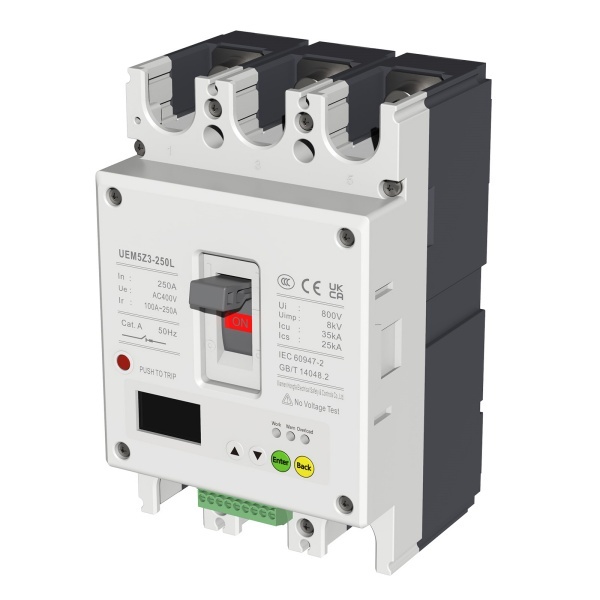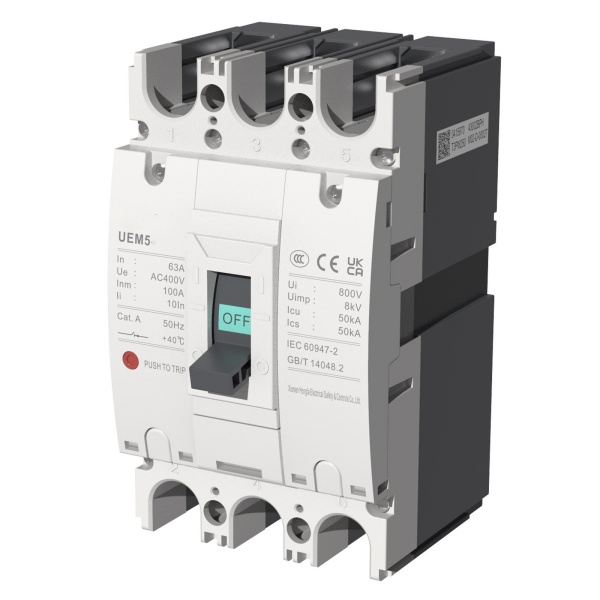As a key component in the electrical system, the low-voltage circuit breaker not only plays an important role in the control circuit, but also provides multiple protection functions to ensure the safety and stability of the electrical system. Its diverse types and wide application make it an indispensable part of modern electrical engineering. Next, we will discuss in detail the functions of low-voltage circuit breakers and their applications in different occasions.

UEM5Z3 Intelligent MCCB Circuit Breaker
1 Commonly used low-voltage circuit breakers
1.1 Universal circuit breaker (standard type is DW)
The universal circuit breaker has a large capacity and can be equipped with a variety of trippers. The number of auxiliary contacts is also large. Different tripper combinations can form different protection characteristics, so it can be used as selective or non-selective or motor protection with inverse time action characteristics. It can realize remote control and intelligent control through auxiliary contacts. Its rated current is 630~5000A. It is generally used for the main switch of the 400V side outgoing line of the transformer, busbar contact switch or large-capacity feeder switch and large motor control switch.
The universal circuit breaker series developed by China include DW15, DW16, and CW series; the products with imported technology include ME series (DW17) of AEG of Germany, AH series (DW914) of Terasaki of Japan, AE series (DW19) of Mitsubishi of Japan, 3WE series of Siemens, etc., as well as the high-tech switches named by domestic manufacturers after their own products.
1.2 Molded case circuit breaker (standard type is DZ)
The main feature of the molded case circuit breaker is that all components are installed in a plastic shell, without exposed live parts, which improves the safety of use. The new molded case circuit breaker can also be made into a selective type. The circuit breaker of small capacity (below 50A) adopts non-energy storage type closure and manual operation; the operating mechanism of the circuit breaker of large capacity adopts energy storage type closure, which can be operated manually or by motor. Motor operation can realize remote control operation. The rated current is generally 6A~630A, with single pole, two pole, three pole and four pole. At present, there are large molded case circuit breakers with rated currents of 800A to 3000A.
Molded case circuit breakers are generally used for distribution feeder control and protection, low-voltage side outlet main switches of small distribution transformers, power distribution terminal control and protection, and residential distribution terminal control and protection. They can also be used for power switches of various production machinery.
The molded case circuit breaker series developed by China include: DZ20 series, DZ25 series, and DZ15 series. The TO, TG and TH-5 series of Terasaki Company of Japan, 3VE series of Siemens, M series of Mitsubishi Company of Japan, M611 (DZ106) and SO60 series of ABB, C45N (DZ47) series of Schneider, etc., as well as high-tech molded case circuit breakers named after their respective products by the manufacturers.
Its derivative products include DZX series current limiting circuit breakers, residual current operated protection circuit breakers with residual current protection function (leakage protection function), phase loss protection circuit breakers, etc.
2 Main technical characteristic parameters and selection of low-voltage circuit breakers
2.1 Characteristics and technical parameters
China’s low-voltage electrical appliance standards stipulate that low-voltage circuit breakers should have the following characteristic parameters:
(1) Type:
The circuit breaker type includes the number of phases, number of poles, rated frequency, arc extinguishing medium, closing mode and breaking mode.
(2) Main circuit rating:
The main circuit ratings are:
① Rated working voltage; ② Rated current; ③ Rated short-time connection capacity; ④ Rated short-time withstand current.
The rated current of universal circuit breakers is also divided into the rated current of the main circuit and the rated current of the frame level.
(3) Rated working system:
The rated working system of the circuit breaker can be divided into two types: 8h working system and long-term working system.
(4) Auxiliary circuit parameters:
The auxiliary circuit parameters of the circuit breaker are mainly the characteristic parameters of the auxiliary contacts. Universal circuit breakers generally have 3 pairs of normally open contacts and normally closed contacts for signal devices and control circuits; molded case circuit breakers generally do not have auxiliary contacts.
(5) Others:
In addition to the above items, the characteristic parameters of the circuit breaker also include: release type and characteristics, usage category, etc.
2.2 Selection of circuit breakers
When the rated current is below 600A and the short-circuit current is not large, a molded case circuit breaker can be selected; when the rated current is large and the short-circuit current is also large, a universal circuit breaker should be selected.
General selection principles are:
(1) Circuit breaker rated current ≥ load working current;
(2) Circuit breaker rated voltage ≥ rated voltage of power supply and load;
(3) Circuit breaker release rated current ≥ load working current;
(4) Circuit breaker limit breaking capacity ≥ maximum short-circuit current of the circuit;
(5) Line end single-phase to ground short-circuit current/circuit breaker instantaneous (or short-circuit) release setting current ≥ 1.25;
(6) Circuit breaker undervoltage release rated voltage = line rated voltage.
3 Intelligent low-voltage circuit breakers
The introduction of microprocessors and computer technology into low-voltage electrical appliances not only makes low-voltage electrical appliances have intelligent functions, but also enables low-voltage switchgear to enter the computer network system through the central control system.
The introduction of microprocessors into low-voltage circuit breakers greatly enhances the protection function of circuit breakers. The short delay in its three-stage protection characteristics can be set to I2t characteristics to better match the next level of protection and realize ground fault protection.
The protection characteristics of intelligent trip devices with microprocessors can be easily adjusted, and early warning characteristics can also be set. Intelligent circuit breakers can reflect the effective value of load current, eliminate high-order harmonics in input signals, and avoid false operations caused by high-order harmonics.
The use of microprocessors can also improve the self-diagnosis and monitoring functions of circuit breakers, monitor and detect voltage, current and protection characteristics, and use LCD display. When the internal temperature rise of the circuit breaker exceeds the allowable value, or the contact wear exceeds the limit value, an alarm can be issued.
Intelligent circuit breakers can protect motors under various starting conditions, and have high action accuracy and a wide setting adjustment range. They can protect motors from overload, phase failure, three-phase imbalance, grounding and other faults.
Intelligent circuit breakers can also automatically record the operation of circuit breakers and realize telemetry, remote control and telesignaling by forming a network with control computers.

UEM5 AC MCCB Circuit Breaker
Intelligent circuit breakers are the direction of transformation, improvement and development of traditional low-voltage circuit breakers. In recent years, China’s circuit breaker manufacturers have also developed and produced various types of intelligently controlled low-voltage circuit breakers. I believe that intelligent circuit breakers will have greater development in China in the future.
Post time: 7 月-18-2024


